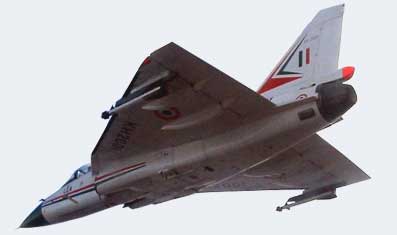HAL Tejas
 The HAL Tejas (Sanskrit: "Radiance") is a lightweight, supersonic multirole fighter aircraft being developed by India. It is a tailless, compound delta wing design powered by a single engine.
The HAL Tejas (Sanskrit: "Radiance") is a lightweight, supersonic multirole fighter aircraft being developed by India. It is a tailless, compound delta wing design powered by a single engine.The LCA programme was launched in 1983 for two primary purposes. The principal and most obvious goal is the development of a replacement aircraft for India's ageing Mikoyan-Gurevich MiG-21 fighters. The LCA programme's other main objective is to serve as the vehicle for an across-the-board advancement of India's domestic aerospace industry.
One of the most ambitious requirements for the LCA was the specification that it would have "relaxed static stability". Most aircraft are designed with "positive" static stability, which means they have a natural tendency to return to level and controlled flight in the absence of control inputs; however, this quality tends to oppose the pilot's efforts to maneuver. An aircraft with "negative" static stability, on the other hand, will quickly depart from level and controlled flight unless the pilot constantly works to keep it in trim; while this enhances maneuverability, it is very wearing on a pilot relying on a mechanical flight control system. What made RSS practical was a new technology - the "fly-by-wire" flight control system - which employs flight computers to electronically keep the aircraft's instability in check whenever it is not desired.
Another critical technology area tackled for indigenous development by the ADA team is the Tejas' Multi-Mode Radar (MMR). It was initially planned for the LCA to use the Ericsson Microwave Systems PS-05/A I/J-band multi-function radar,[11] which was developed by Ericsson and Ferranti Defence Systems Integration for the Saab JAS-39 Gripen;[12] however, after examining other radars in the early 1990s,[13] the DRDO became confident that Indian industry was up to the challenge.
Although it had been decided early in the LCA programme to equip the prototype aircraft with the General Electric F404-GE-F2J3 afterburning turbofan engine, a parallel programme was also launched in 1986 to develop an indigenous powerplant. Being led by the Gas Turbine Research Establishment, the GTRE GTX-35VS, christened "Kaveri", was expected to replace the General Electric F404-GE-IN20 on all production aircraft. The GTRE's design envisions achieving a fan pressure ratio of 4:1 and an overall pressure ratio of 27:1, which it believes will permit the Tejas to "supercruise" (cruise supersonically without the use of the afterburner).
The Tejas is single-engined multirole fighter which features a tailless, compound delta-wing planform and is designed with "relaxed static stability" for enhanced maneuverability. Originally intended to serve as an air superiority aircraft with a secondary "dumb bomb" ground-attack role, the flexibility of this design approach has permitted a variety of guided air-to-surface and anti-shipping weapons to be integrated for more well-rounded multirole and multimission capabilities.
The tailless, compound-delta planform helps keep the Tejas small and lightweight - in fact, it is reputed to be the smallest and lightest 4th-generation combat jet in the world.[31] The use of this planform also minimises the control surfaces needed (no tailplanes or foreplanes, just a single vertical tailfin), permits carriage of a wider range of external stores, and confers better close-combat, high-speed, and high-alpha performance characteristics than comparable cruciform-wing designs. Extensive wind tunnel testing on scale models and complex computational fluid dynamics analyses have optimised the aerodynamic configuration of the LCA, giving it minimum supersonic drag, a low wing-loading, and high rates of roll and pitch.
All weapons are carried on one or more of seven hardpoints: three stations under each wing and one on the under-fuselage centreline. There is also an eighth, offset station beneath the port-side intake trunk which can carry a variety of pods (FLIR, IRST, laser rangefinder/designator, or reconnaissance), as can the centreline under-fuselage station and inboard pairs of wing stations.
The Tejas has a night vision goggles (NVG)-compatible "glass cockpit" that is dominated by an indigenous head-up display (HUD), three 5 in x 5 in multi-function displays, two Smart Standby Display Units (SSDU), and a "get-you-home" panel. Target acquisition is accomplished through a state-of-the-art radar - potentially supplemented by a laser designator pod, forward-looking infra-red (FLIR) or other opto-electronic sensors - to provide accurate target information to enhance kill probabilities. A ring laser gyro (RLG)-based inertial navigation system (INS) provides accurate navigation guidance to the pilot.
General characteristics
Length: 13.20 m (43 ft 4 in)
Wingspan: 8.20 m (26 ft 11 in)
Height: 4.40 m (14 ft 9 in)
Wing area: 38.4 m² (413 ft²)
Empty weight: 5,500 kg (12,100 lb)
Loaded weight: 8,500 kg (18,700 lb)
Powerplant:
1× General Electric F404-GE-F2J3 turbofan, 80.5 kN (18,100 lbf); or
1× General Electric F404-GE-IN20 turbofan, 83.2 kN (18,700 lbf);or
1× GTRE GTX-35VS Kaveri turbofan, 89.9 kN (20,000 lbf)
Performance:
Maximum speed: Mach 1.8, 1,920 km/h (1,195 mph) at high altitude
Range: 2000 km
Service ceiling: 15,250 m (50,000 ft)
Wing loading: 221.4 kg/m² (45.35 lb/ft²)
Thrust/weight: 1.07
Armament:
Single internally mounted 23 mm twin-barrel GSh-23 cannon with 220 rounds of ammunition.
Eight external stations:
Air-to-air missiles include Astra BVRAAM, Vympel R-77 (AA-12 Adder), and Vympel R-73 (AA-11 Archer).
Air-to-surface munitions include anti-ship missiles, laser-guided bombs, unguided bombs, cluster bombs, and unguided air-to-surface rockets.
Links:
www.combataircraft.com
www.airforce-technology.com
www.bharat-rakshak.com
www.fighter-planes.com
(Adapted from http://www.wikipedia.org/ )
Labels: aircraft, aviation, compound delta wing, dreamhost promocode, HAL Tejas, India, lightweight, links, Mikoyan-Gurevich MiG-21, Radiance, relaxed static stability, supersonic, tailless




0 Comments:
Post a Comment
<< Home